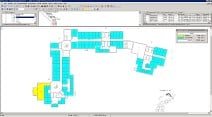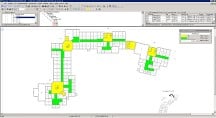BIM is Green
Krasny, A. Zimic, M. Gribajcevic, A. Koluder-Agic,
Walter, Bosnia and Herzegovina
Abstract
The use of BIM is on the rise in AEC industry, mainly in design and construction, facilitating green design and sustainability, but still far from reaching its peak. There are great unused potentials and benefits of BIM use in facility management. This paper will provide an overview of the advantages of BIM in synergy with green design on the example of projects from Walter’s company portfolio. One of the goals of this paper is to raise the awareness on the fact that green design can accelerate BIM adoption.
Keywords:
BIM, green design, facility management, Revit
1. INTRODUCTION
Green design is continuously transforming AEC industry in its aim of achieving greater level of sustainability. Recognizing its benefits, industry practitioners are progressively embracing green design, realising that BIM is a game-changer on this journey.
1.1 Building Information Modelling
Building Information Modelling is a process of development of a digital information model of a building that is used by all the stakeholders in the building’s lifecycle. By the use of technology and digital information, it improves AEC processes, their outcomes and building operation. It is a key facilitator of an improved decision-making process during the whole lifecycle [1]. Although it cannot be considered new, it represents a disruptive technology in the AEC industry, which is why it is being slowly accepted and implemented. Its full benefits are yet to be reaped, especially in the largest share of the sector – existing buildings.
1.2 Building stock
In today’s world, new construction represents only a small percentage of the existing building stock. In the EU, this percentage is about 1% a year, while more than 40% of the existing stock was built before 1960 and 90% before 1990 [2].
According to the data of the Directorate-General for Energy of the European Commission, buildings are responsible for 40% of energy consumption and 36% of CO2 emissions in the EU [3],
with significant potential of energy savings through renovations, retrofitting and improvement of energy efficiency. In addition, it is estimated that on average, 60-85% of the total lifecycle costs of a building are incurred during its occupancy, after its construction [4].
Those costs are usually not considered during the design phase, most likely due to the fact that the design competitions decide the winners based on the on the capital costs of construction, and not on the long-term value of a building.
2. BIM FOR FACILITY MANAGEMENT
Out of the five distinct phases in a building’s lifecycle (design, engineering, construction, maintenance and operation), currently the highest level of adoption and use of BIM is in the first three phases, utilizing the majority of ‘BIM Dimensions’ (3D – spatial, 4D – time and 5D – cost) [5].
BIM 6D refers to the post-construction phase (maintenance and operation) of the building and it is mostly identified with ‘sustainability’, being primarily aimed at improvement of the efficiency of FM practices that are directly linked to the lifecycle performance of the building. An example of the data used in 6D can be information about installed components: the manufacturer, installation dates, maintenance schedule, configuration to achieve optimal performance, energy performance, lifespan and decommissioning. Such comprehensive data facilitates better decision-making as early as during design phase, allowing designers to assess various options and scenarios and their effects across the building’s lifecycle.
2.1 Benefits of BIM
The main advantage of a BIM model is easy access to information stored within and the ability to share that information with all the relevant parties – contractors, repairmen, inspectors, etc. Something that was previously stored, exchanged, hidden and lost in a multitude of paper files, folders and databases, is now contained in a visual, graphical representation of the queried element. It enables proactive facility management with regard to space assignments, planning of preventive maintenance activities, budgets, expenses and contingencies, warranty management, regulatory compliance and energy usage, resulting in maximum efficiency of operation, improved coordination, efficient facility documentation, and accessible energy audit information, something that this discipline struggled with in the past.
3. MODEL CREATION
Documentation used for creation of BIM models for facility management can include all kinds of sketches, blueprints and drawings, scanned documents, CAD files, PDFs, laser scans, photographs, aerial imaging, etc.
The resulting BIM models can then be used in various applications, from FM systems to mobile applications and augmented reality. 3.1 BIM to FM Facility managers are not commonly involved in the process of building design, which means that the BIM models created for construction do not satisfy the requirements of FM operations. After BIM to FM handover, information in such models needs to be sifted through for pieces of information that need to be passed forward, but more commonly gaps need to be identified and filled with FM information. This process can cause significant post-commissioning delays in achieving efficient operation [6].
3.2 BIM for FM
Advantages of BIM justify the BIM for FM process – creation of BIM models for the purpose of facility management. This process involves collecting all available documentation that is needed for the end purpose. The model is built with the level of development that enables placing any elements that are needed for asset management, analysis and simulation. In order to maintain reaping these benefits, the BIM model needs to be constantly updated with the information about repairs, replacements, changes and renovations, as well as any other type of information that is essential for decision making.
4. CASE STUDIES
4.1 Company Background
Founded in 2011 in Sarajevo, Bosnia and Herzegovina, Walter is a company providing expert BIM services and solutions to clients from the AEC industry. It employs over 70 highly-skilled individuals organized in several business units that cover all areas of BIM application – from programming, content development, testing, modelling, design, reality capture, FM, BIM management. Through our partnership with Symetri from Sweden, the majority of our clients come from the Nordic countries, bringing with them their unique requirements and challenges. Symetri is the foremost service provider in model and drawing-related IT. Their main task is to improve and develop the management and utilization of property data and information [7].
DoBIM, Digital Objectifying BIM, is one of Walter’s Business departments whose main task is to create, capture and store data in the form of BIM models. Providing services mainly to customers from Sweden, which is famous for its residential market and complex SIS standards covering building areas [8], specific tools needed to be developed to manipulate with different area types in a BIM model. Most commonly used software is Autodesk Revit, with Naviate addins for area manipulation and information extraction.
After completion, BIM models with all the relevant information are exported in the form of xml files and raster images that are published into a FM system used by the customer (most commonly HyperDoc/HyperHouse and FM Access). The customer then accesses the information and the drawings through a web-based portal that is customized to their FM needs, and the models are kept in an archive service and updated upon request. Through the process of objectification (creation of a model, based on building components – ‘objects’) using BIM software, an information-rich 3D model is created, enabling easy access and extrapolation of various information, such as room areas or rental information, and also allowing the end user to use it for designing renovations or add more features to the building component objects, such as flooring materials, fire/sound insulation class on doors etc.
4.2 AutoCAD as a BIM tool – Micasa
For some customers, switching to sophisticated BIM tools, such as Revit, is not an easy choice, especially when they have been basing their FM system on AutoCAD Architecture for decades. One of such customers is Micasa, a FM operator from Stockholm region. The images below show an example of a detailed site drawing (Figure 1) created from an aerial photo (Figure 2) and confirmed by site inspection, with information about landscape – vegetation (type and age of different plants), lawn areas (for grass-cutting contracts), lighting, street furniture etc. linked to AutoCAD objects via their specific layers. This information is then exported together with the raster image to the FM System (HyperDoc/HyperHouse – Figure 3). When compared with Revit, AutoCAD Architecture does not offer as many BIM analysis tools as Revit, but it is still sufficient for certain needs that enable proactive maintenance and more efficient decision making, thus not providing enough incentives to switch to true BIM.

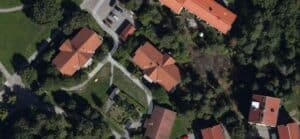
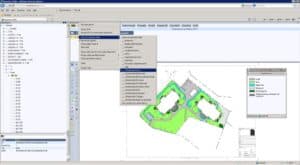
4.3 Space Management – Botkyrkabyggen
Botkyrkabyggen is another client managing the building stock of social housing in Stockholm. Their buildings were built during the ‘million programme’ in late 1960s and have only recently decided to switch to a digital FM system, having a mostly scanned and incomplete archive of old drawings as a basis. Their building stock was also in need of serious renovation, being also a site of recent demonstrations, and their residents, mainly immigrants, are of a lower economic standard. All these factors influenced their decision to modernize their FM operations using BIM to create models that will also be used for design of massive renovations aimed at increasing the living standard of their residents and property value at the same time.
The first models were created from old scanned drawings in very poor condition, sometimes only electrical or plumbing drawings would be available, as illustrated by Figure 4.
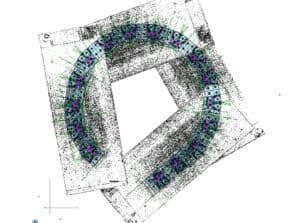
The resulting model (Figure 5) was clean, filled with necessary information about apartments and communal areas, with measurable elements that immediately proved its value for renovation works.

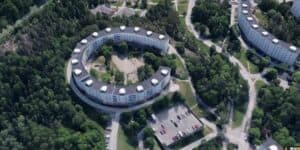
The information that was entered in the Revit model was mainly concerning the areas, grouping rooms in apartments under their contract number, apartment type, etc. This comprehensive information was then exported into the FM System (HyperDoc/HyperHouse) (Figure 7), which provides various tools for quick extrapolation and visualization of different types of data.
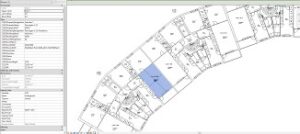
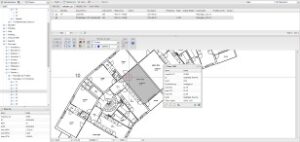
The client later decided to switch to the newest product in the FM software – FM Access, and the transition was very simple and straightforward, as the two application use the same export formats .xml and .cal. (Figure 8 and 9).

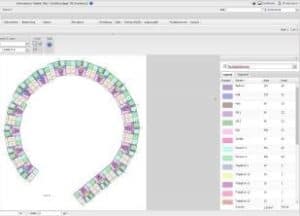
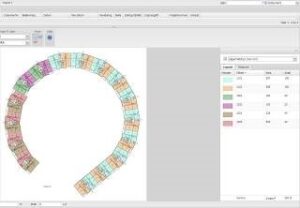
This was only the first phase of our work with this client. After receiving our BIM model, and seeing the results in the FM system, having all the required data at their disposal, the client was quick to recognize the benefits and advantages and the next project stage followed, this time using laser scanning of the buildings they did not have accurate current drawings and BIM model construction based on point clouds, which also included more elements than before and higher level of development. Figure 10 shows the end result of the first such project – model of a communal building owned by the customer.
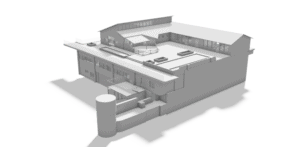
The work done for Botkyrkabyggen was an excellent example of the benefits BIM can provide for facility owners and managers, providing them accurate and accessible information and BIM models that can be reused for renovation works and subsequent updating of their FM system, saving time and money in the process.
4.4 Space Management – Signalisten
Signalisten is another company owning residential buildings in the Stockholm region. This example is interesting because of an added layer of information to the usual space management requirements. In addition to creation of BRA, BTA and NTA areas for every room in the buildings, contract numbers and apartment types, this client also required the information about Area Classes and Cleaning Classes, which was easily achieved in Revit, adding additional room parameters.
That way, rooms were also classified into:
- BOA (apartments, living area),
- BIA (building facility, service areas),
- ÖVA (vertical and horizontal circulation, areas for technical services and equipment),
- LOA – (business spaces).
Figure 11 shows the aerial photo of a building in a Stockholm suburb, whose model was created during this project. Reference drawings used were CAD drawings.
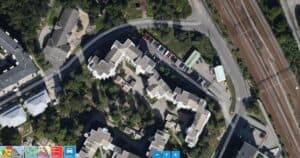
The process of area manipulation – adjusting the usable (BRA), gross (BTA) and net (NTA) area of the rooms in the model – requires a special tool that creates the areas automatically and then enables manual editing of each area boundary, in order to correct possible errors, so that it would satisfy the SIS Standard requirements imposed on housing operators in Sweden. Revit creates a separate plan for each level and area type, as shown in Figure 12.

After the model is completed, the usual export files are created for integration into the FM System (HyperDoc/HyperHouse), which is also adjusted to the customer’s special area requests and provides useful tools for filtering according to selected criteria to enable easier visualization and review of information. Figures 13, 14 and 15 show the examples of those visualization tools.


